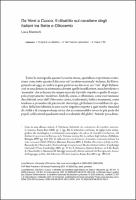Chapter Da Verri a Cuoco. Il dibattito sul carattere degli Italiani tra Sette e Ottocento
| dc.contributor.author | MANNORI, LUCA | |
| dc.date.accessioned | 2022-06-01T12:16:28Z | |
| dc.date.available | 2022-06-01T12:16:28Z | |
| dc.date.issued | 2020 | |
| dc.identifier | ONIX_20220601_9788855181600_399 | |
| dc.identifier.issn | 2704-5919 | |
| dc.identifier.uri | https://library.oapen.org/handle/20.500.12657/56216 | |
| dc.description.abstract | Even today, Italians tend to adopt a double imagine of their national character, played on the contrast between an evolved and conscious minority (‘us’) and a backward and typically pre-modern majority (‘them’). As Giulio Bollati has shown better than any other in a famous essay, this self-representation draws its origins first of all from the period between the late Enlightenment and the early Napoleonic age, in which for the first time the Peninsula was called to deal with the models imposed by the great European modernization. The paper aims to reconstruct the process that led some of the most prominent political thinkers of this years (Baretti, Verri, Gioia, Botta, Cuoco) to adopt the image mentioned above - and this privileging the approach of the constitutional history. | |
| dc.language | Italian | |
| dc.relation.ispartofseries | Studi e saggi | |
| dc.subject.other | National characters | |
| dc.subject.other | Italian identity | |
| dc.title | Chapter Da Verri a Cuoco. Il dibattito sul carattere degli Italiani tra Sette e Ottocento | |
| dc.type | chapter | |
| oapen.identifier.doi | 10.36253/978-88-5518-160-0.06 | |
| oapen.relation.isPublishedBy | bf65d21a-78e5-4ba2-983a-dbfa90962870 | |
| oapen.relation.isbn | 9788855181600 | |
| oapen.series.number | 214 | |
| oapen.pages | 17 | |
| oapen.place.publication | Florence |

